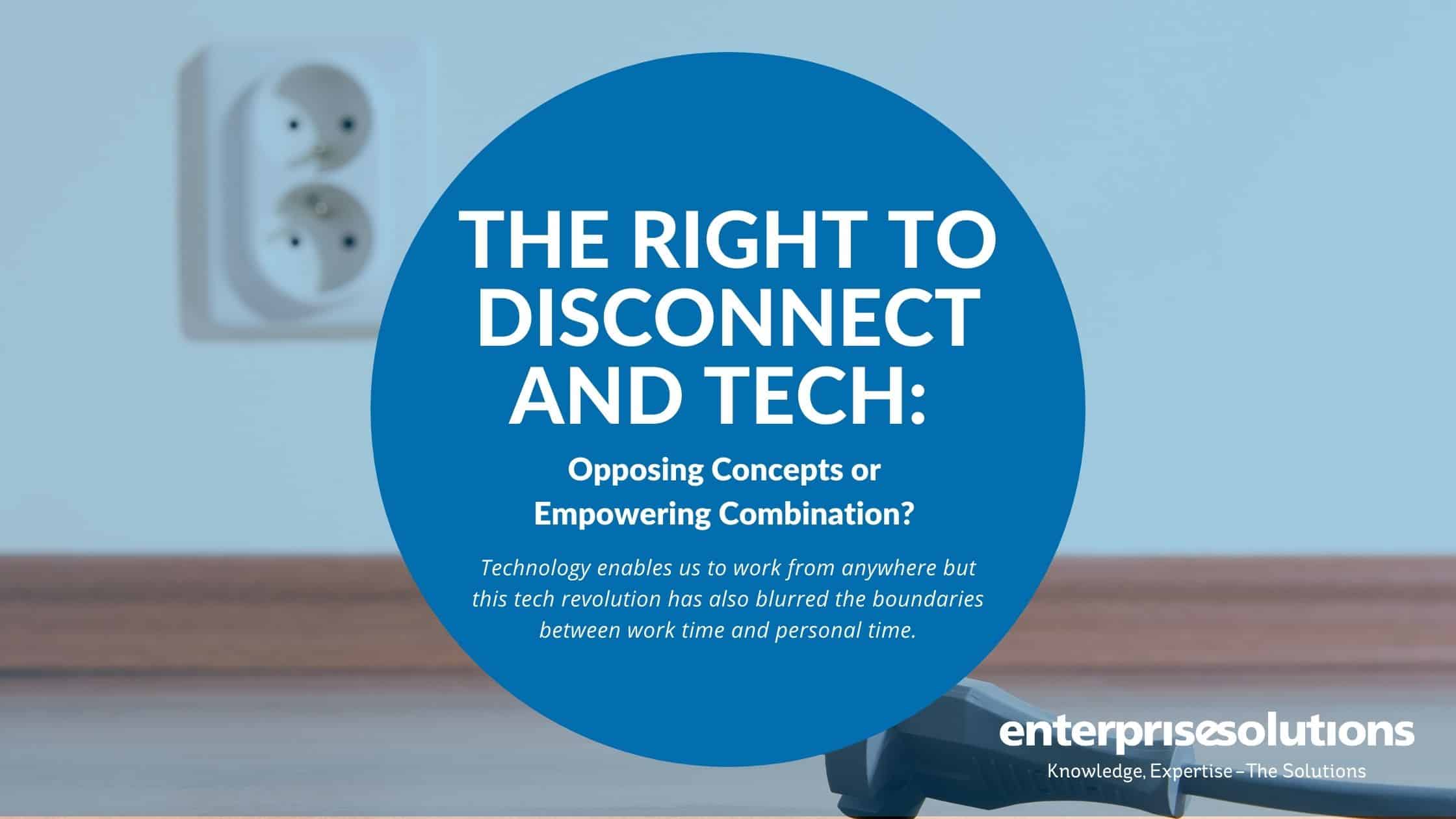The Right to Disconnect and Tech: Opposing Concepts or Empowering Combination?
According to a recent Laya Healthcare Survey, 91% of Irish workers have reported some level of anxiety during Covid-19, with 1 in 10 seeking help with their mental wellbeing. This may have stemmed from many employees struggling to “switch off” when it comes to work.
For many of us working remotely, we know all too well how difficult it can be not to check our laptops and phones when we get a notification, even when we’re on lunch or finished work for the day! We now find it much harder to separate our work time from our personal time. While technology empowers us to work from home the same way that we do in the office, this tech revolution has blurred the boundaries between work time and personal time.
As of April 2021, all employees officially have the Right to Disconnect from work and have a better work-life balance, after Tánaiste and Minister for Enterprise, Trade and Employment Leo Varadkar TD brought in a new Code of Practice. The code is part of the Tánaiste’s commitment to create more flexible, family-friendly working arrangements, including working from home and working more flexible hours. The Tánaiste highlighted how the “pandemic has transformed working practices, and many of those changes will be long-lasting”. He went on to say that “although much of the impact of the pandemic has been negative, particularly for those who have lost jobs, income or whose businesses have been closed, it also offers an opportunity to make permanent changes for the better”. The aim of the Code is to “help employees, no matter what their job is, to strike a better work-life balance and switch off from work outside of their normal working hours.”
Similarly, Minister of State for Business, Employment and Retail, Damien English TD, said: “The right to disconnect has never been more important following a seismic shift in work practices this time last year, as Government asked people who could work from home to do so in the interest of suppressing the virus … It will ensure that both employers and employees are aware of their requirements and entitlements and understand how they apply, especially when it is time to unplug and recharge the batteries by switching off properly from work, especially in a remote working scenario.”
The Code of Practice will require employers and employees to work together to determine the appropriate working arrangements and policies. As the Code is flexible, employees will have more options to work outside of traditional hours, which many people have availed of during the pandemic. This reflects the fact that many Irish employees are part of a global network, requiring contact with colleagues around the world.
What’s getting in the way of digital wellness?
When companies across the globe were forced to shift how they worked overnight, millions of employees and teams made great efforts to adapt. Kitchens became boardrooms. Collaboration tools became lifelines. Housemates became officemates. Productivity, balance, and resilience took on new meanings. These rapid responses helped us stay productive and meet customers’ needs. However, the juggle is real and the cost to people’s wellbeing is not sustainable.
Also, with the haste to roll out additional technology to support remote working, and an expectation for employees to rapidly adopt that technology, there can be complaints and consequences as it relates to tech adoption. Quartz research points to three key consequences:
1.Distractions to your productivity – We know all too well that we receive notifications on the regular and with the constant alerts from clients, customers, and colleagues, we find ourselves jumping between applications.
2. We can’t seem to switch off – As we are working from home, many of us feel that we need to always be active and doing something to prove that we can work from home effectively. As our office is now at our kitchen table or bedroom; we live, eat, sleep, and relax in our office so there is no separation between work and home. As a result, we can see the notifications coming in and have constant access to our work – therefore, we are always switched “on”.
3. Decision over-load – While technology enables us to work from home, it can be overwhelming for end-users due to the wide variety of applications, tools, and systems at our fingertips.
What can you do about it – now and in the long term?
Quartz research calls attention to three key attributes that can guide tech decisions toward digital wellness:
1.Tech that allows for more productivity: employers can encourage employees to make use of technology that allows scheduling, blocked off times and limited notifications to allow them to be more productive
2. Tech that allows for mobility: technology has evolved and can now enable employees to work from anywhere, anytime and on any device while being secure.
3. Tech that allows for automation: tasks such as administration and manual reporting can be extremely time consuming so technology that automates work can allow employees to focus more on their main duties and save time
To thrive amid great change, we need organizational cultures that make it easier to recharge, connect, and do our best work. In terms of technology, Microsoft have been investing in this space for years with tools such as MyAnalytics and Workplace Analytics. Available with most Enterprise Office accounts, these tools can be set up by an administrator and utilised by all.
MyAnalytics from Microsoft
MyAnalytics provides insights into two of the key factors in personal productivity: how people spend their time and who they spend it with. MyAnalytics is an extension of your Microsoft 365 client experience that helps you find opportunities to build better habits and get back in control of your time. It uses everyday data from Microsoft 365 to give you insights into how you spend your time.
At a high level, the tool offers users the ability to see how they spend their time via a dashboard highlighting work patterns, productivity insights and information about who they collaborate with and how. The add-in for Outlook allows for contextual, data driven recommendations to improve processes and patterns, as well as offering a weekly digest that highlights your previous week.
As a result of the pandemic, Microsoft have recently brought these insights into Microsoft Teams and adding exciting experiences designed to help people harmonize wellbeing with productivity.
Partnering with Headspace, the Teams integration will offer meditations, mindfulness, and other digital wellness activities. With personal productivity insights, users can schedule dedicated focus time, receive daily briefing emails and recommendations based on their current habits.
Remove the Noise
Making smaller changes can also be effective in terms of combatting burnout among employees. Turning off notifications when not at work, scheduling breaks, planning time away from work and using delay deliveries to ensure you are only contacting co-workers within their agreed working hours can make a huge difference for those struggling to switch off whilst WFH. Those in a managerial role can implement strategies such as the above to really highlight the importance of switching off after hours, for those who want it.
Combatting “Zoom Fatigue”
Some companies have been seen to implement “No Meeting” days, ranging in the specifics from blocking whole days off for solo work to creating a camera-free environment one day a week. Citigroup are one example of a company who banned Friday Zoom calls to ease the pandemic stress. A Texas based company has introduced “focused Wednesday afternoons” where employees are encouraged to not communicate electronically at all; whilst Clorox has taken a similar approach one day a month, reports the Guardian.
Conclusion
We are in a live-demo environment of a global WFH shift. The most important action is to find what works for your business. With the Right to Disconnect code being introduced, the Government are recognising a problem with employee burnout during the pandemic. Employers and businesses should take a look at their own companies and see what will help their teams thrive in such a trying time. Technology has helped us all stay connected over the past year, and although it can be seen as the cause of this “always-on” work mode, it can be crucial in how businesses tackle the issue going forward.
From small changes such as no emails out of hours to implementing larger scale policies like adapting tools such as MyAnalytics, Enterprise Solutions are experts in helping businesses adapt for the evolving digital workplace. Talk to one of our team members about how you can empower your employees and your business through technology.
Contact us via email, phone or social media.

As Marketing Manager, Conor takes joy in bringing news, blogs and industry innovations to Enterprise Solutions readership. He has a keen interest in all new innovative software and devices.




